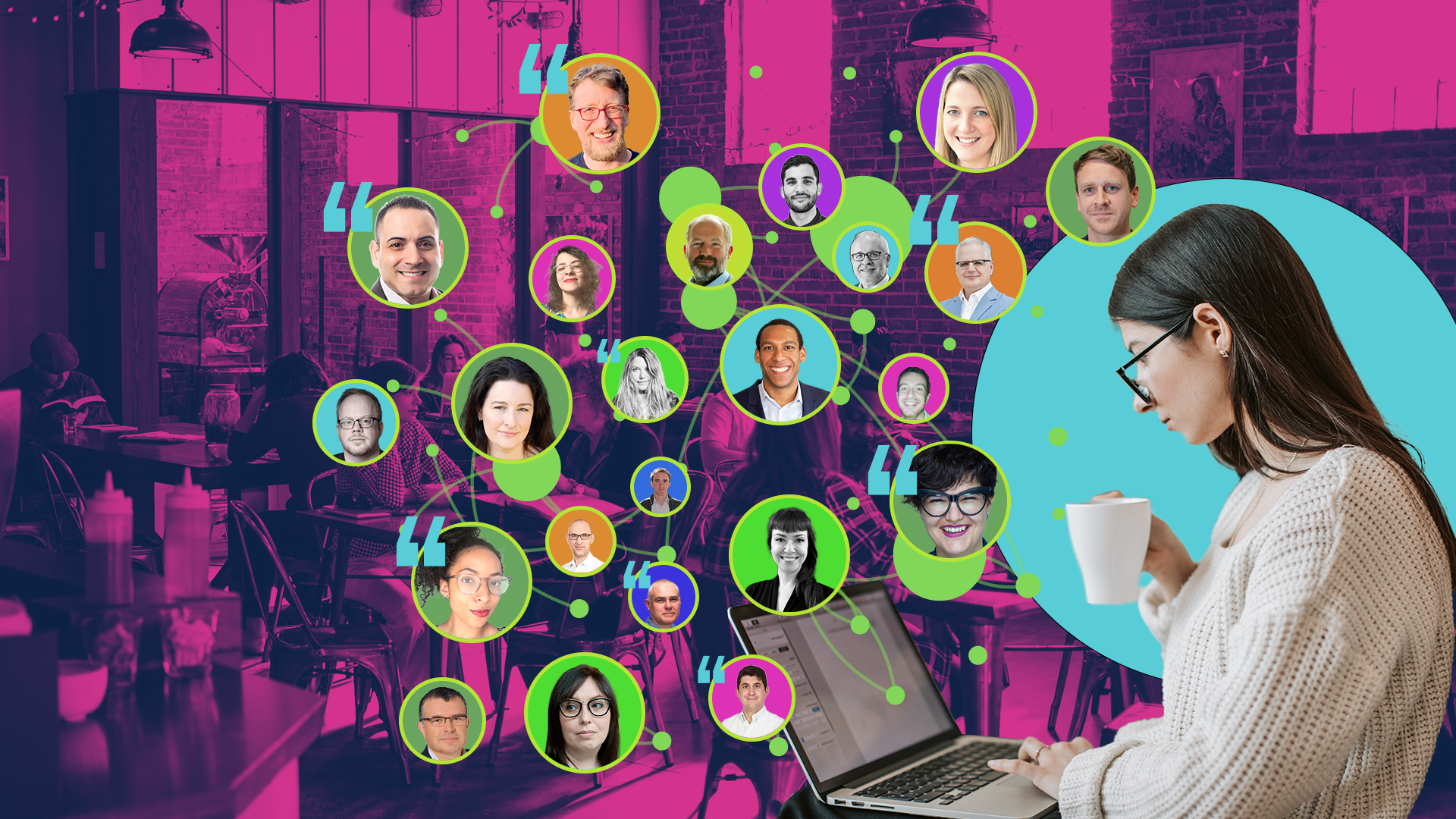35 quotes from industry leaders to inspire your 2021
One of our own marketing highlights this year has been all the collaborations we have done with industry leaders. We have considerably expanded our network of contacts to produce: guest blogs, interviews, (virtual) events and podcasts. We have always aimed to share the most valuable information, fresh ideas and perspectives from the most talented professionals within the sector.
We have selected the most insightful contributions of 2020 (by topic) to inspire you in the upcoming year. We hope you find it useful!
- Audience intelligence
- Consumer segmentation
- Cultural understanding
- Personalised marketing
- Creativity data
- The cookie-less world
- In times of pandemic...
Audience intelligence
“Audience intelligence is the process of architecting audiences, dissecting them into smaller clusters, and then analyzing patterns, habits and behavior. The result is actionable and defendable insights that you can use to make data-informed decisions.” (original article) | Michael Brito, EVP of Digital & Analytics at Zeno Group
“Audience intelligence is essential and should sit in the heart of any media planning strategy. It is the foundational layer to any successful media plan. -1.png?width=300&name=Disen%CC%83o%20sin%20ti%CC%81tulo%20(11)-1.png) Once the initial audience intelligence has been researched and set out, from there it is possible to calculate the correct mix of channels, formats, and targeting strategies to reach the audience at the right time and place.” (original article) | Danielle Johns, Senior Audience Strategist at Encore Digital Media
Once the initial audience intelligence has been researched and set out, from there it is possible to calculate the correct mix of channels, formats, and targeting strategies to reach the audience at the right time and place.” (original article) | Danielle Johns, Senior Audience Strategist at Encore Digital Media
“Audience intelligence is probably the most important data you can use to break through the noise and really make an impact. It puts you in the same environment, the same mindset, and the same playing field as your customers. It takes you from the zoo, straight to the jungle.” (original article) | Michael Brito, EVP of Digital & Analytics at Zeno Group
Consumer segmentation
“A few clicks of a button and a semiautomatic process can give you insights rich enough to set up your whole strategy. That’s bloody remarkable! Not .png?width=300&name=Disen%CC%83o%20sin%20ti%CC%81tulo%20(21).png) long ago people were spending hundreds of thousands of pounds on a survey-based clustering exercise to achieve this. With social media data and tools like these, the cost is not hundreds of thousands - you can get the results you need at zero marginal cost once you've got a subscription!” (original article) | David Boyle, audiencestrategies.com
long ago people were spending hundreds of thousands of pounds on a survey-based clustering exercise to achieve this. With social media data and tools like these, the cost is not hundreds of thousands - you can get the results you need at zero marginal cost once you've got a subscription!” (original article) | David Boyle, audiencestrategies.com
“The vast majority of an audience are lurkers, people that don't engage  regularly. They don't communicate with you, they're not commenting on your posts. They're not liking and sharing. They're not freely sharing how much they love their new Yeti mug or whatever it might be. But they are people that could be your most valuable audience segments.” (original article) | India White, Founder & Chief Strategist at Port Tack
regularly. They don't communicate with you, they're not commenting on your posts. They're not liking and sharing. They're not freely sharing how much they love their new Yeti mug or whatever it might be. But they are people that could be your most valuable audience segments.” (original article) | India White, Founder & Chief Strategist at Port Tack
“Why would you be looking for performance indicators? If you're carrying out audience research your KPIs apply to your own organisation, they don't apply to you. If you approach a problem thinking that you need KPIs you're building a brick wall for yourself." (original article) | Edward Bass, Creative Digital Strategist
“When planning a successful campaign we ask ourselves questions like: where is our audience spending time online? Do they read and engage with certain news publishers, social media platforms etc? And which websites are they more likely to visit based off the accounts they follow? This is important for cross-channel optimisation and creating niche advanced whitelists.” (original article) | Danielle Johns, Senior Audience Strategist at Encore Digital Media
Cultural understanding
.png?width=300&name=Disen%CC%83o%20sin%20ti%CC%81tulo%20(17).png) “We move from analysing social media as a means of understanding ‘what people are saying’ – which has never been true: most people don’t actively post to social - to recognising its value is really in media consumption, that is, culture.” (original article) | Jay Owens, Research & Insight consultant
“We move from analysing social media as a means of understanding ‘what people are saying’ – which has never been true: most people don’t actively post to social - to recognising its value is really in media consumption, that is, culture.” (original article) | Jay Owens, Research & Insight consultant
“Audience intelligence isn't a new approach, but a great way to dive into the data that is available today to better understand audiences beyond demographics and what we’ve been relying on for so long (broad assumptions and predetermined segments), to then understand our audiences through who they truly are.” (original article) | India White, Founder & Chief Strategist at Port Tack
.png?width=300&name=Disen%CC%83o%20sin%20ti%CC%81tulo%20(15).png) “Twitter data can show us how people behave when they can be immersed in their interests. How that relationship will affect what they consume and what they put online. If you’re tasked with understanding a particular audience with a passion, chances are Twitter data is a good starting point.” (original article) | Beatriz Montenegro, Research Analyst at Twitter Brazil
“Twitter data can show us how people behave when they can be immersed in their interests. How that relationship will affect what they consume and what they put online. If you’re tasked with understanding a particular audience with a passion, chances are Twitter data is a good starting point.” (original article) | Beatriz Montenegro, Research Analyst at Twitter Brazil
“Communication has always been about society, facing into the world rather than into the business and a focus on people is what makes social intelligence what it is. You don’t need to be a data scientist to use data. In fact, some of the leaders in social intelligence started out in comms roles.” (original article) | Jillian Ney, Founder of The Social Intelligence Lab
Personalised marketing
“Personalisation is a wonderful thing. But not when it comes at the cost of strategic understanding. As discovery, trial and consumption race towards digital channels across every industry, companies face unprecedented opportunities to personalise every consumer experience. However, many companies invest in tactical personalisation at the expense of the strategic guidance that an audience strategy offers.” (original article) | David Boyle, audiencestrategies.com
“Consumers want relevance in the marketing messages they receive from brands. So whether it’s on a personal, persona or broader segment level .png?width=300&name=Disen%CC%83o%20sin%20ti%CC%81tulo%20(28).png) using these experiences is essential. Getting this right can offer brands benefits beyond, and sales too. Our research suggests that successful personalisation actually reassures customers and makes them more willing to share their data with a brand. Meaning that successfully personalising your marketing, as a brand, can quickly become a virtuous cycle.” (original article) | Tim Bond, Head of Insight and PR at Data & Marketing Association
using these experiences is essential. Getting this right can offer brands benefits beyond, and sales too. Our research suggests that successful personalisation actually reassures customers and makes them more willing to share their data with a brand. Meaning that successfully personalising your marketing, as a brand, can quickly become a virtuous cycle.” (original article) | Tim Bond, Head of Insight and PR at Data & Marketing Association
“Persona marketing, done well, groups our target audiences based on common interests or characteristics to create customer-centric strategies and experiences that will resonate with each group in a personalized manner. We need to be sure our personas are accurate and reflect consumer fragmentation. We all like to feel unique and receive individual messages, but as I said, leaving sensitive information outside of the equation.” (original article) | Tamara Lucas, Associate director at Convosphere
Creativity data
“From informing creative executions based on audience insights, to planning how to best build cross-media campaigns programmatically that enable multi-channel messaging, and finally through to the execution, where learnings can be applied during the campaign to enable in-flight optimisation across channels, data should be utilised throughout the whole campaign process." (original article) | Jean-Christophe Conti, CEO of VIOOH
.png?width=300&name=Disen%CC%83o%20sin%20ti%CC%81tulo%20(29).png) “Creativity is not controlled by one influence. Creativity has always been developed through insight, even if the idea is instinctively created, it’s been created by someone that understands the brand, product and audience. Data only adds and supports the creative process.” (original article) | Mike White, CEO & founding partner at Lively Worldwide
“Creativity is not controlled by one influence. Creativity has always been developed through insight, even if the idea is instinctively created, it’s been created by someone that understands the brand, product and audience. Data only adds and supports the creative process.” (original article) | Mike White, CEO & founding partner at Lively Worldwide
“Too often marketers see a conflict between data and creativity, with the former typically seen as stymying the latter. This perceived incompatibility is a version of C. P. Snow’s ‘The two cultures’ all over again. Snow made his complaint about arts versus sciences back in the 1950s - can’t we move on? If the system’s working properly, data doesn’t stymy creativity. It does the very opposite: it helps to unlock its potential by making creative assets more customisable, adaptable, relevant, fleet-of-foot and nuanced in the delivery. As an industry, we might not quite be there yet when it comes to a seamless intermeshing of the two, but the future possibilities are endless and exciting.” (original article) | Geoff Copps, Managing partner, head of data at Kinesso - an IPG company
 “A digital campaign without a data-led and informed planning approach is a recipe for disaster. A data-led pre-campaign approach offers you deep insights before a pound or dollar is spent, which also creates your campaign strategies to deliver super targeted and efficient performance.” (original article) | Mike Gray, Head of Client Strategy & Engagement at MiQ
“A digital campaign without a data-led and informed planning approach is a recipe for disaster. A data-led pre-campaign approach offers you deep insights before a pound or dollar is spent, which also creates your campaign strategies to deliver super targeted and efficient performance.” (original article) | Mike Gray, Head of Client Strategy & Engagement at MiQ
“Data has the capacity to inform a host of decisions and strategies for brands. However, there should always be room for surprise too. As such, creativity that is informed by data leaves room for human interventions and interpretation.” (original article) | Tim Bond, Head of Insight and PR at Data & Marketing Association
-1.png?width=300&name=Disen%CC%83o%20sin%20ti%CC%81tulo%20(34)-1.png) “Audience data is a blueprint. Just like an architect who designs a house using 3D software, marketers can use data to build data-informed campaigns. The result: creative storytelling and advertising that can break through clutter and reach audiences with memorable, impactful and game-changing programs.” (original article) | Michael Brito, EVP of Digital & Analytics at Zeno Group
“Audience data is a blueprint. Just like an architect who designs a house using 3D software, marketers can use data to build data-informed campaigns. The result: creative storytelling and advertising that can break through clutter and reach audiences with memorable, impactful and game-changing programs.” (original article) | Michael Brito, EVP of Digital & Analytics at Zeno Group
“Great creatives informed by data are only half of the formula to achieving memorable advertising; ensuring that the execution is relevant, seen in the right context, and by the right audience is just as critical”. (original article) | Jean-Christophe Conti, CEO of VIOOH
“The data and learnings need to flow across different channels, not just the departments. The creative output should be informed by each channel’s performance and engagement, not treated ‘in-silo’ or judged independently if the goal is sequential storytelling or driving an action.” (original article) | Mike Gray, Head of Client Strategy & Engagement at MiQ
The cookie-less world
“More brands will be able to stay true to who they really are vs chasing .png?width=300&name=Disen%CC%83o%20sin%20ti%CC%81tulo%20(30).png) results or deep data analytics that may convince them to stray out of their core identity. There are many platforms that are and always will be cookie-less, such as real life experiences, print publishing, TV and radio. We might see greater focus and spend spread to these channels in the future.” (original article) | Laura Cooper, Senior insights and strategy manager at Rankin
results or deep data analytics that may convince them to stray out of their core identity. There are many platforms that are and always will be cookie-less, such as real life experiences, print publishing, TV and radio. We might see greater focus and spend spread to these channels in the future.” (original article) | Laura Cooper, Senior insights and strategy manager at Rankin
“The need to get insights from advertising and social networks will not stop growing and it will not change in the future. Let's hope that the depreciation of third-party cookies does not further fragment the vision that we have of users online, generating even more silos.” (original article) | Oscar López Cuesta, Audience Chapter Leader at Orange
“The main challenge in programmatic advertising is addressing the slow demise of the third-party cookie. Privacy regulations and changes in tracking mechanisms means there has been a drop off in the number and range of third-party data segments programmatic marketers use and have relied on for over a decade. In response to this shift, we have become more creative in the way we start to understand and target audiences.” (original article) | Danielle Johns, Senior Audience Strategist at Encore Digital Media
“Hopefully it (the end of 3rd-party cookies) will allow creativity to thrive again. Cookie's only helped us influence audiences and drive a form of digital direct marketing. Now we can get back to developing great ideas and targeting them through understanding what media channels they consume and creating relevant and engaging ideas. The creative industry will not be affected by this only the tech companies and media agencies driving programmatic advertising will suffer. (original article) | Mike White, CEO and founding partner at Lively Worldwide
“Moving to a cookie-less world shouldn't be considered as losing any personalization capabilities, but as an open door to explore and innovate. As marketers, we may lose the ability to hit a potential buyer with the last .png?width=300&name=Disen%CC%83o%20sin%20ti%CC%81tulo%20(31).png) article she checked on our website through the entire internet, something increasingly annoying for people outside the industry. We won't lose the ability to understand the consumers that talked about or/and bought our products in the last month, the messages they are using and their interest and behaviours, allowing marketers to develop campaigns that mix digital customer insights with other personalization variables such as date, weather or the location." (original article) | Tamara Lucas, Associate director at Convosphere
article she checked on our website through the entire internet, something increasingly annoying for people outside the industry. We won't lose the ability to understand the consumers that talked about or/and bought our products in the last month, the messages they are using and their interest and behaviours, allowing marketers to develop campaigns that mix digital customer insights with other personalization variables such as date, weather or the location." (original article) | Tamara Lucas, Associate director at Convosphere
In times of pandemic...
“In this extraordinary time, we underline more than ever that decision-makers should take decisions based on solid, unbiased and fact-based .png?width=300&name=Disen%CC%83o%20sin%20ti%CC%81tulo%20(32).png) evidence. The data, research, and insights sector can be a critical source of such evidence and guidance; essential research and analyses on the behaviour and attitudes of both citizens and consumers should be maintained, encouraged and intensively used by governments, businesses and charities alike, particularly now." (original article) | Joaquim Bretcha, Netquest International Director & ESOMAR President
evidence. The data, research, and insights sector can be a critical source of such evidence and guidance; essential research and analyses on the behaviour and attitudes of both citizens and consumers should be maintained, encouraged and intensively used by governments, businesses and charities alike, particularly now." (original article) | Joaquim Bretcha, Netquest International Director & ESOMAR President
“Understanding what the key dynamics are, and acting on them, will be critical for business success in the recovery stage. Times of crisis create a sense of flux for consumer behaviour and we need to be engaged and empathetic to the new realities many will find themselves in. Against this backdrop we should also be enthused, as the coming months – probably years – will be the most interesting times for new audience understanding and insights for a generation.” (original article) | Peter White, Exec Director, Marketing Intelligence at OMD EMEA
“The current situation will help marketers to use social data to understand their audiences better. I hope also that brands will get more clarity on their role in peoples' lives and take more responsibility for it. As a consequence of lockdown, conversations at all levels are being channelled through social. People are telling us about their feelings and reactions to adversity, often at a profound level. Some brands may be openly discussed less, but the customers of all brands are talking about themselves more. We are learning what really matters and far-sighted marketers will apply this knowledge as part of the 'new normal'.” (original article) | Philip Lynch, Independent consultant & lecturer at University of Westminster
“We’re living in a world where we now understand that media audiences are  not at all monolithic. And this concept becomes hyper-relevant in the ‘new normal’ times we’re living in, because while there is truly a collective experience happening – ‘We’re all in this together!’ – it’s also true that different affinity groups or demographic segments will respond to the new realities and new trends in different ways. It’s not enough to assume a generally popular idea will apply to the specific audience you care about.” (original article) | Marc Geffen, VP, U.S. Strategy & Research at Pulsar Platform
not at all monolithic. And this concept becomes hyper-relevant in the ‘new normal’ times we’re living in, because while there is truly a collective experience happening – ‘We’re all in this together!’ – it’s also true that different affinity groups or demographic segments will respond to the new realities and new trends in different ways. It’s not enough to assume a generally popular idea will apply to the specific audience you care about.” (original article) | Marc Geffen, VP, U.S. Strategy & Research at Pulsar Platform
"At the time when we every part of our lives is being disrupted hugely by the confinement measures, everything from our family lives to our ability to earn a living, the socio-economic impact of that is tremendous. Through social .png?width=300&name=Disen%CC%83o%20sin%20ti%CC%81tulo%20(26).png) data and opinion research, we are able to break through assumptions about those impact that may just not be true. In a time of great change, we need robust compasses to make sure we're not travelling down a road that we may not wish to go down. Now more than ever taking evidence-based decisions can really make a different in restoring a semblance of normal quickly and boosting societal trust and confidence at a time when we need both the most." (original article) | Kim Smouter, ESOMAR Head of Public Affairs & Professional Standards
data and opinion research, we are able to break through assumptions about those impact that may just not be true. In a time of great change, we need robust compasses to make sure we're not travelling down a road that we may not wish to go down. Now more than ever taking evidence-based decisions can really make a different in restoring a semblance of normal quickly and boosting societal trust and confidence at a time when we need both the most." (original article) | Kim Smouter, ESOMAR Head of Public Affairs & Professional Standards
“Your consumers are likely to have changed significantly based on their experiences over the past few months. It’s crucial that all brands systematically assess their current approach to audiences and targeting to understand whether it’s designed for a transformed consumer landscape.” (original article) | Peter White, Exec Director, Marketing Intelligence at OMD EMEA
“Listening is always an important skill in insights, but at the moment it is the key skill. In order to ask questions, you need to know what the right questions are. At the moment, while we are all flying blind, we are less sure that we know the questions – so listening is key. Find out what people are saying to each other, decode what they mean, and analyse what it means for your business.” (original article) | Ray Poynter, Founder of NewMR
“Social media data is essential to keeping abreast with the changing communication landscape at the moment. While qualitative research is .png?width=300&name=Disen%CC%83o%20sin%20ti%CC%81tulo%20(33).png) coming to a near-halt, quantitative research may slow down. Bearing in mind that they capture a moment in time with self-reported data, social media gives us the opportunity to chime in with the developing conversation and community clusters online. This makes a truly observational approach possible, and even longitudinal research a potential, for us to gain insight into the evolving consumer/human reality around the globe.” (original article) | Nisa Bayindir, EVP of Behavioural Science at Pulsar Platform
coming to a near-halt, quantitative research may slow down. Bearing in mind that they capture a moment in time with self-reported data, social media gives us the opportunity to chime in with the developing conversation and community clusters online. This makes a truly observational approach possible, and even longitudinal research a potential, for us to gain insight into the evolving consumer/human reality around the globe.” (original article) | Nisa Bayindir, EVP of Behavioural Science at Pulsar Platform
Audiense is committed to having a more diverse and inclusive selection of contributors and industry thought leaders in our articles. If you’re interested in collaborating with us, please emailleticia@audiense.comand include your specialist areas of expertise, and/or preferred subjects for commentary.






